Archived Content
This archived web page remains online for reference, research or record-keeping purposes. This page will not be altered or updated and may contain out of date information. If you’re looking for specific information and haven’t found it, please contact communications@camosun.ca.
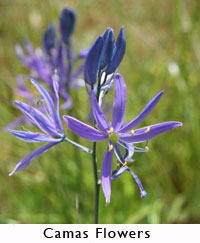 Reviving a sweet tradition
Reviving a sweet tradition
Every spring at Camosun’s Lansdowne campus, bright blue camas flowers spatter the Garry oak meadows. Radiating from stems about 18 inches high, star-like buds signify all that is left of a once bountiful plot of camas bulbs, cultivated and maintained for centuries by the Songhees First Nation (Lekwungen) and core to their food and trade needs.
Camosun’s first annual Camas harvest demonstration and pit cook, held at Lansdowne campus on June 23, strengthened this link to First Nations traditions and teachings.
It took “a lot of people chipping in” says Cheryl Bryce, from the Songhees Land Management Department, to obtain a fire permit and coordinate the throng of interested people from local traditional territories, Camosun’s First Nations and Anthropology departments, other post-secondary institutions (including some students from Italy) 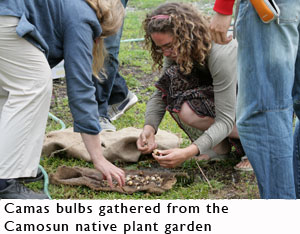 and a number of other invited guests.
and a number of other invited guests.
Just like regular potatoes
Anna Spahan, an elder from the Tsartlip First Nation in Brentwood Bay, says that when she was a child, camas was her family’s “number one vegetable. We ate them just like regular potatoes.”
Dr. Nancy Turner, an ethnobotanist and professor in the University of Victoria’s School of Environmental Studies, learned “all she knew” about camas from Spahan’s father, Chris Paul. “In the late 60’s he used to grow them in his garden, some as big as light bulbs, and serve them at Saanich barbeques,” says Turner.
Only a very few First Nations families eat the camas bulb now. 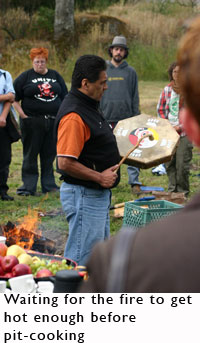 Events promoting traditional use of the camas “keep the teachings, teach our younger people. We don’t want it to disappear,” says Spahan.
Events promoting traditional use of the camas “keep the teachings, teach our younger people. We don’t want it to disappear,” says Spahan.
The sweet art of pit-cooking
The First Nations harvested both the bulbs of the Common camas (Camassia quamash), and Great camas (Camassia leichtilinni). Camas was not only a main source of carbohydrate for a family, but the pit-cooked bulb was also an integral part of indigenous trading culture.
Camas bulbs’ bland complex sugar inulin (also found in onions) is broken down during the lengthy pit-cooking technique to sweet fructose. The process involves a fire-pit where the burning wood is replaced with a base of hot rocks and then camas bulbs are placed between multiple layers of locally harvested plants such as sword fern, salal or skunk cabbage, with the heat sealed in a final layer of soil. Ideally, the bulbs are pit-cooked overnight because the longer they cook, the sweeter the blackened fig-like product. Since traditional First Nations food gathering produced a low supply of sweet foods, pit-cooked camas was a valuable commodity, sometimes pounded into a powder and used to enhance other foods.
Working with nature
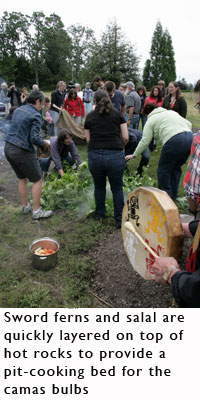 Each family group traditionally “owned” their own camping and harvesting spot. Traditional harvesting coaxed nature to produce bigger yields. Bigger bulbs were encouraged by using a pointed digging stick to loosen the soil and by the use of selective harvesting. New growth was encouraged by breaking apart and transplanting “mother” bulbs as well as timing the harvest so it would also scatter seeds from the earlier flower.
Each family group traditionally “owned” their own camping and harvesting spot. Traditional harvesting coaxed nature to produce bigger yields. Bigger bulbs were encouraged by using a pointed digging stick to loosen the soil and by the use of selective harvesting. New growth was encouraged by breaking apart and transplanting “mother” bulbs as well as timing the harvest so it would also scatter seeds from the earlier flower.
A similar but toxic bulb, "death camas" (Zigadenus venenosus), was removed and all invading weeds were discouraged with controlled burn after the harvest, opening up the meadow by “removing larger plants & shrubs and providing a shot of fertilizer for the roots” says Turner.
Only five percent of camas lands are in the same state they were before European contact. They are an inherent part of the fragile Garry oak ecosystem which is characterized by moist flat meadows and grasslands, scattered stands of transitional forests and dry rocky outcrops with shallow soils. Known for their great beauty, biological diversity and unique association of plants, these rare ecosystems are threatened by urban development and severe habitat loss.
A way to learn
The camas harvest and pit cook “is part of who we are”, says Bryce. “It helps with reinstating traditional First Nation roles, restoring the environment and ecosystem, and connecting with homelands.”
The gathered crowd absorbed more than just information on successes and 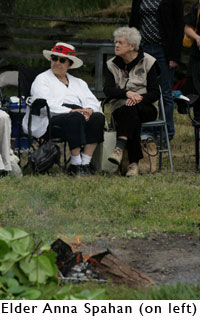 challenges in managing traditional foods. Greg Sam, Aboriginal Relations Coordinator at Royal Roads University, identified this in his welcoming prayer. As pit-fire smoke swirled through a huge Garry oak, standing for centuries over a meadow once lush with camas, Sam invited us to not only learn, but celebrate and “eat that good feeling.”
challenges in managing traditional foods. Greg Sam, Aboriginal Relations Coordinator at Royal Roads University, identified this in his welcoming prayer. As pit-fire smoke swirled through a huge Garry oak, standing for centuries over a meadow once lush with camas, Sam invited us to not only learn, but celebrate and “eat that good feeling.”
Interested in Camosun College’s First Nations programs?
We offer services and programs for First Nations, Métis, Inuit, and Native American students—we support other First Nations programs in the college, and we help provide linkages between Camosun College, First Nations students, and the local First Nations community. More information...
Last updated: February 14, 2013 11:18 am


